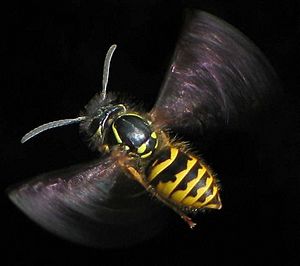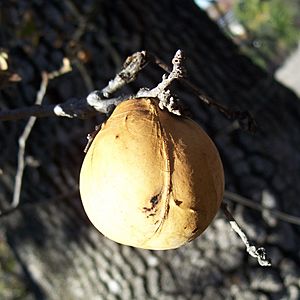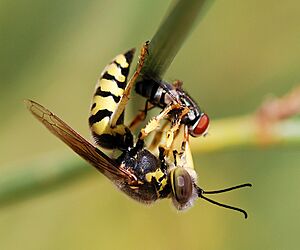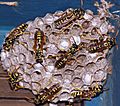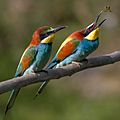Wasp facts for kids
Wasps are amazing insects that are related to ants and bees. They belong to a big group of insects called Hymenoptera.
There are two main types of wasps:
- Social wasps: These live in groups, like the common wasps you might see in your garden or hornets. They build nests together.
- Parasitic wasps: Most wasps are actually this type! They live alone and are super important for controlling other insect populations. They often lay their eggs on or inside other insects.
Wasps are very helpful in nature because they help keep the number of "pest" insects in check. Farmers even use some types of parasitic wasps to protect their crops from harmful insects without using chemicals. This is called biological control.
Contents
What Wasps Look Like
Many people sometimes mix up wasps and bees, but it's actually quite easy to tell them apart! Bees usually look quite fuzzy or hairy, while wasps are smooth and shiny.
Wasps have special mouths for biting and antennae that have 12 or 13 parts. Most wasps have wings. A cool thing about wasps is their "waist" – their body is very thin where their main body (thorax) connects to their back part (abdomen).
Only female wasps have a sting. They use it not just for defense, but also for laying eggs. Adult wasps mostly drink nectar from flowers. But their babies, called larvae, need more protein. So, the mother wasp feeds them insects or pollen.
Social Wasps and Their Nests
Most wasps that live in groups are called social wasps. These include paper wasps, yellow jackets, and hornets. They are famous for building nests out of paper!
How Wasps Make Paper Nests
Social wasps make their nests by chewing up tiny bits of wood and mixing it with their saliva. This creates a paste that they use to build paper-like cells, similar to the honeycomb that bees make with wax. They build these cells into a nest.
Wasp Life Cycle
The queen wasp lays an egg in each cell of the nest. When the egg hatches, a tiny larva appears. Worker wasps then feed these larvae by bringing them insects that they have chewed up. There's one special group, the pollen wasps, whose larvae eat only pollen and nectar.
Unlike honeybees, most social wasp colonies don't survive the winter. Only the queen wasp lives through the cold months. She finds a safe, hidden spot to hibernate, like inside hollow trees, under bark, or even in the walls of buildings.
In the spring, the queen wakes up and starts a new colony all by herself. She builds a few cells, lays some eggs, and takes care of the first few larvae. Once these larvae grow into adult worker wasps, they take over all the work – building more of the nest, finding food, and caring for new larvae – while the queen focuses on laying more eggs.
Parasitic Wasps
There are over 100,000 different kinds of parasitic wasps, and they are incredibly diverse! Most adult parasitic wasps don't eat their prey. Like bees, butterflies, and moths, they usually get all their food from nectar.
Parasitic wasps are called "parasitoids" because their larvae live on or in another insect, eventually killing it. Many lay their eggs in the eggs or pupae of other insects. Sometimes, they sting their prey to paralyze it using their ovipositor (a special tube for laying eggs). Then, they lay one or more eggs on or inside the paralyzed host. The host insect stays alive until the wasp larvae are big enough. The host usually dies when the wasp larvae turn into pupae or when they emerge as adult wasps.
Farmers often buy these parasitic wasps to help control insect pests in their fields.
Solitary Life of Wasps
The mud dauber is a common type of solitary wasp. You can easily spot it because it has a very long, thin "waist." The female mud dauber collects mud and uses it to build a special nest for her young.
She uses her ovipositor to sting and paralyze small insects, spiders, and caterpillars. She then stuffs these paralyzed creatures into the mud nest cells. After each cell is full, she lays an egg inside, seals the opening, and leaves. When the eggs hatch, the larvae have a fresh feast waiting for them until they grow into adult wasps.
Some solitary wasps create strange growths on plants called galls. These galls form around the wasp's egg after it's laid. Scientists aren't entirely sure what makes the plant grow around the egg, but the gall acts like a protective home for the developing wasp. You can often find galls on the branches of oak trees in late summer.
Other wasps lay their eggs directly into wood. The young wasp larvae then eat the tree itself, making circular tunnels as they grow. They stay in the wood until they are ready to become adult wasps and crawl out of the tree.
Wasp Stings and Allergies
Most wasps don't sting unless they feel threatened or bothered. A wasp sting can be painful, but for most people, it's just a normal reaction from their immune system. You might see some swelling, redness, and feel pain around the sting. You can usually help this by putting a cold compress on it, raising the area, and taking pain relief if needed.
However, a few people are allergic to wasp stings. This is more serious. If someone gets stung and then has symptoms far away from the sting, like a spreading rash, itching, trouble breathing, a tight chest, swollen lips or face, feeling faint, or nausea, they need to get medical help right away.
To avoid stings, it's good to understand how wasps behave. They are often attracted to sweet foods and smells, especially in the autumn when they are very hungry. So, be careful with sugary drinks and snacks when wasps are around.
Other pages
Images for kids
-
Male Electrostephanus petiolatus fossil from the Middle Eocene, preserved in Baltic amber
-
Tarantula hawk wasp dragging an orange-kneed tarantula to her burrow; this species has the most painful sting of any wasp.
-
European hornet, Vespa crabro
-
Spider wasp (Pompilidae) dragging a jumping spider (Salticidae) to provision a nest
-
Minute pollinating fig wasps, Pleistodontes: the trees and wasps are mutualistic.
-
The parasitoidal ichneumon wasp Dolichomitus imperator ovipositing through wood, using its immensely long ovipositor to lay its eggs inside hidden larvae, detected by vibration
-
The Chrysididae, such as this Hedychrum rutilans, are known as cuckoo or jewel wasps for their parasitic behaviour and metallic iridescence.
-
The wasp beetle Clytus arietis is a Batesian mimic of wasps.
-
The bee-eater, Merops apiaster, specialises in feeding on bees and wasps.
-
Encarsia formosa, a parasitoid, is sold commercially for biological control of whitefly, an insect pest of tomato and other horticultural crops.
-
Wasp waist, c. 1900, demonstrated by Polaire, a French actress famous for this silhouette
-
Black wasp Sphex pensylvanicus (Sphecidae) feeding on nectar
See also
 In Spanish: Avispa para niños
In Spanish: Avispa para niños


